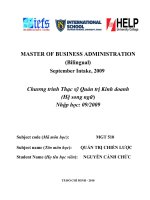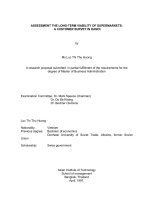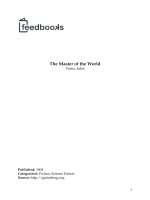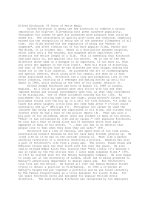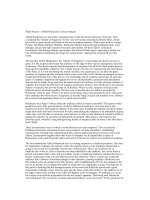alfred hitchcock master of suspense
Bạn đang xem bản rút gọn của tài liệu. Xem và tải ngay bản đầy đủ của tài liệu tại đây (31.24 KB, 2 trang )
Alfred Hitchcock, also known as "Master of Suspense," was a director who loves to manipulate
the audience through his films. As a director, he always stayed in touch with his childish fears.
Ever since his father taught him a lesson about what happens to "naughty boys," he always feared
police. Hitchcock recalled that "the sound of that closing cell door and the bolt" never left his
memory. Director of such works as Psycho and Dial "M" for Murder, Hitchcock told his stories
through suspense.
In the documentary, "Film on Film," Hitchcock lets us know his secrets in successfully making a
great film. In all of his films, the Hitchcock villain is a person you'd never suspect. The most
everyday character is really the murderer. In Hitchcock's eyes, no one is ever truly innocent.
Everyone in his films is guilty of something. For example, in Dial M for Murder, Margot is not
really the innocent victim because she was cheating on her husband. The second technique
Hitchcock uses is to have places familiar to the audience as settings for danger. He sometimes
uses landmarks to show complete order and have disorder happen there. Other times he uses
places that everyday people go to. For example, in Psycho, danger happened in a hotel that the
audience is familiar with as a place where you can safely rest. This is to allow the audience to
think that danger can happen anywhere and that it can happen to anyone. Another technique that
Hitchcock used to build suspense was to let the audience know more about the plot than
characters. This is to leave the audience helpless when they know that something is going to
happen. This is known as the bomb theory. But must not happen with the bomb theory is that the
bomb must not go off. This is so that it won't ruin the suspense from the audience.
Psycho is one of the most famous and well-known films in the history of American cinema. It was
shot in black in white even though the technology of color movies was around. For many reasons
it was a great achievement. The film tricked the audience into believing it was telling one story,
then shifted to tell another by killing off its leading lady halfway through the film. He did it
perfectly without disappointing or losing its audience. A strange figure enters and repeatedly stabs
Marion with a knife to shrieking music. The music adds a lot of tension and suspense to the
audience. This adds tension and also keeps the audience in suspense because the audience knows
that something will happen in that part. The audience is then terrified and wants to know more.
Another scene that was brilliant was when the detective is stabbed at the top of the stairs and he
falls down. That placement of the camera makes u feel like you are falling with him. Suspense in
Psycho arises from wondering who is going to be killed next. Alfred Hitchcock gives an image
that Norman Bates' mother is alive. He does this by describing Norman Bates as being controlled
by his mother. He does not tell the truth about the mother being dead, but does not lie either.
Norman's mother is dead, but is alive in the mind of Norman. The audience thinks that the mother
is alive and they think she can be the killer in the film. This makes the audience want to see what
really happens in the film.
Hitchcock's Dial M for Murder is another example of pure and classic Hitchcock film. Hitchcock
proves in this version that you don't need fancy clothes and pretty sets to make a film that keeps
you in suspense the whole time. What you do need is good actors, a well-planned plot, and a little
case of attempted murder. One difference between it and most typical mysteries is that we explore
a perfect crime knowing ahead of time what the plan is. We watch in suspense to see if it is
actually going to work and then in dread that it actually might. Hitchcock seems to be the only
director who can make you feel more sorry for the conniving killer than the intended victim. He's
so clever and charming, you almost wish he's get away with it. Hitchcock makes you root for the
creep, which isn't easy to pull off. During the scene where Tony propositions the would-be
murderer in their apartment, the entire scene is shot from the ceiling. The whole time it looked
like you were watching the scene through a security surveillance camera. The next remarkable
point in this movie is the way Hitchcock achieved the creation of a sort of involvement between
murderer, victim and viewer. The viewer is turned into the murderer as he expects almost
frantically Wendice's telephone call. When Tony was late in phoning his wife and the murderer
looked as if he might walk out of the apartment without killing Margot. The audience as well as
Tony was hoping he'd hang on for another few minutes. Another point is when the murderer is
waiting for the right moment to strangle his "victim." It makes the audiences "feel" Margot's
surprise and desperation as well as the murderer's brutal attack on her as it happens.
In conclusion, Hitchcock was a director who planned each of his shots with great care and detail.
His artistry in lighting, camera angle, etc. makes filming a form of art.
